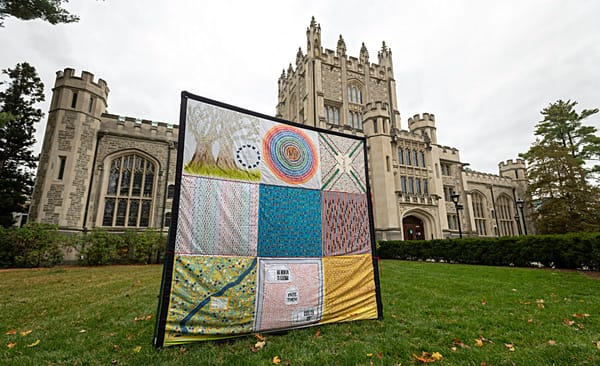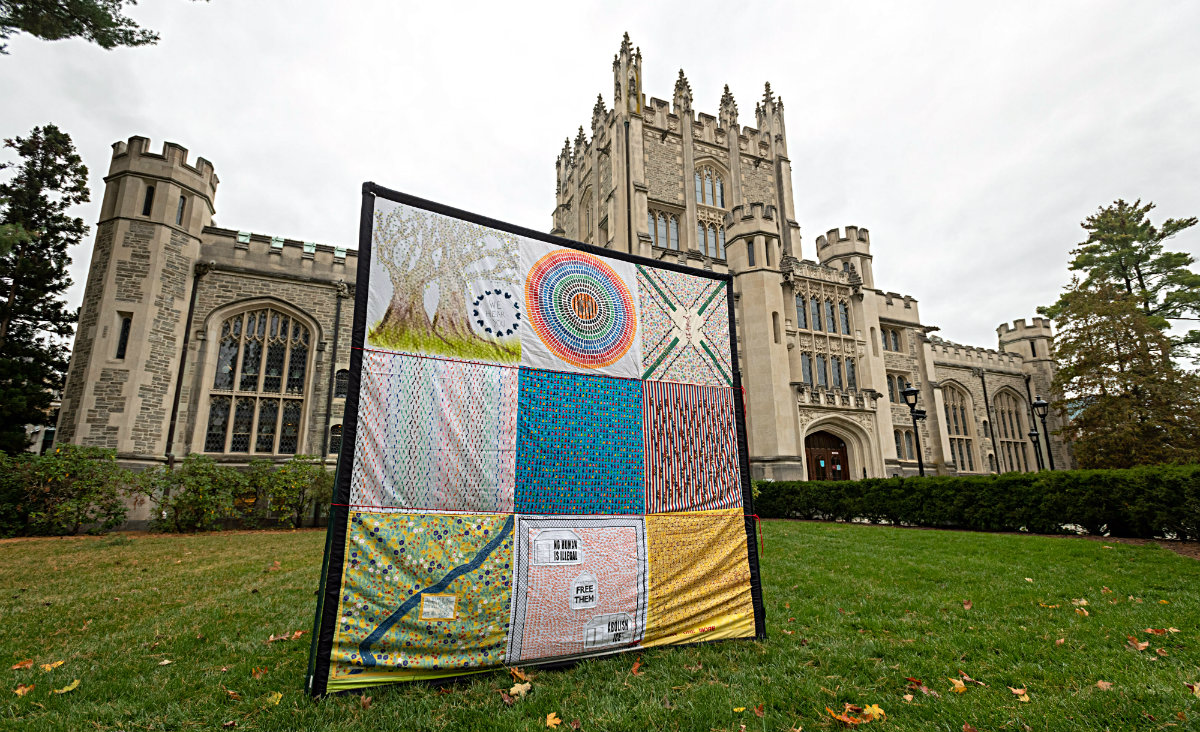The 45,000 Quilt Project Has A Not-So-Cozy Message
The anguish of 45,000 ICE detainees is sewn into quilts as a visual marker of our time.

The anguish of 45,000 ICE detainees is sewn into quilts as a visual marker of our time.

All photos by Karl Rabe
It’s a stunning number to contemplate.
In 2019, it was projected that the daily average of detainees held in U.S. Immigration and Customs Enforcement (ICE) detention centers was 45,000. How do you visualize that? How do you memorialize each one of those individuals?
For Glen Ring, a retired teacher and activist in Concord, New Hampshire, the way was through the The 45,000 Quilt Project, which aims to communicate such volume visually. Quiltmakers throughout the country contributed patches that point attention to the personal anguish experienced by people seeking asylum. Last month, the quilts were on display at Vassar College and will be displayed at various locations in the City of Poughkeepsie until November 20. A display at Vassar’s Frances Lehman Loeb Art Center will be open to the public on November 7.
Ring’s initial idea was for each contributor to make 1,000 marks on their respective patch. She wanted each quilt to be big, for visualizing the detainee population. By way of Facebook and other platforms, she amassed a good number of quiltmakers who sent her patches through the mail. Once the patches made it to Concord, a group of three women sewed them together and added backing.
From Concord the effort spread to 12 U.S. states and Oaxaca, Mexico, with patches coming from over 60 artists and activists. But the project is ongoing. As of this writing, four quilts, each measuring nine feet by nine feet, have been released to the public. When work is finished, when all six sections and 45,000 marks are made, each quilt will be joined together.

Some of the creators have been veteran quiltmakers, others painters. One person experienced in sewing for theater productions made a “special,” three-square-long patch that reads, “The 45,000,” flanked by two cells with the visage of the American flag. Over a background of black and white butterflies — of freedom — is a list of facts about ICE detention centers. From afar, the quilt is lively, kaleidoscopic, swelling with butterflies and birds, but upon closer inspection you can read the realities: medical neglect and abuse, the profit-making function of detention centers, COVID outbreaks among detained asylum seekers. At the center of another quilt is a photo portrait of a staring child with the shadow of a chain-link fence on its face.
Why quiltmaking? Ring wanted a collaborative medium, and one that allowed for self-expression and easy display. There is also a thematic layer. “[Making a quilt] is an interesting contrast to what’s happening to the people in the detention centers,” she said. “A quilt is something that’s very comforting, so it’s almost like people were expressing how they wished they could help the people they can’t really help right now.”
The response has been overwhelmingly positive. One comment in particular stuck with her: a minister from Massachusetts said, “I hope the beauty of it doesn’t get in the way of the message.” It is integral to get close to each piece, not only to scrutinize the messages more closely (many quilts feature a biting, bilingual blend of phrases: “Free Them” and “Liberalos,” and under a matrix of multi-color dots the affirmation “They tried to bury us. They didn’t know we were seeds.”) but also to have the fabrics tower over you and have the marks dominate your vision. It is indeed beautiful, but the density of the surface can be overwhelming with the symbolism in mind.

After a stint in New Hampshire, the pieces traveled to Vassar College, where they were displayed on the library lawn and the Loeb Art Center Sculpture Garden. Valerie Carlisle from the New York grassroots group Grannies Respond/Abuelas Responden had inquired whether the Consortium on Forced Migration, Displacement, and Education at Vassar (funded by the Andrew W. Mellon Foundation) might be interested in displaying the quilts on campus. Tom Pacio, from Vassar's Frances Lehman Loeb Art Center and Creative Arts Across Disciplines, and Geography Lab Coordinator Richard Jones organized the move from New Hampshire and the display at Vassar and throughout Poughkeepsie, including at the Family Partnership Center and Christ Episcopal Church. The quilts are back on Vassar’s campus until Nov. 9, after which they travel to Bard College. The quilts will also be shown at the Glebe House and the Trolley Barn later in November.
The ultimate goal is to take the display to the Senate building in D.C. By then, when the quilts are finished and joined, the product will be 45 feet long. Doubtless the enormity of the thing will catch the eye, allowing viewers to absorb the meaning of the number.
The 45,000 Quilt Project will also be on display at Fall Kill Creative Works in Poughkeepsie on Nov. 8 from 11 a.m. – 2 p.m., weather permitting.
Taylor Stewart is a Vassar junior from Tokyo majoring in English and art history.


